My Password isn’t working or I have forgotton my password.
If you forget your student username: This is your first and last name together, so if your name was “Firstname Lastname”, your username would be: “firstnamelastname”.
If you forget your staff or faculty username: This is your first initial, and your last name – so if your name was “Firstname Lastname”, your username would be: “flastname”.
If you forget your student/staff/faculty password: Navigate to http://password.lcad.edu and follow the on-screen instructions. If you are unable to unlock your account please contacts support@lcad.edu from an alternate email account.
How do I print things at LCAD?
LCAD IT provides several options for you to print your work. There are both free and fee-based options available. Please see the details below.
Free printing options for LCAD students and faculty – available from user-owned devices on the LCAD_Wireless network and from most LCAD lab computers:
There are 6 basic black and white printers available for student and faculty use without any charge. The free student and faculty use printers are listed below:
- The Main Campus student printer is located in the Student Lounge.
- The Big Bend B student printer is located at the end of the main hallway to the right of the Big Bend B reception desk.
- The Big Bend A student printer is located at the Big Bend A reception desk.
- The East Campus student printer is located in the Senior Studios Student Lounge.
- The South Campus student printer is located in South Campus Studio 3.
- The MFA student printer is located on the second floor of the MFA building.
Note1: You must be on the LCAD_Wireless network to complete installation of these printers on your own computer or device! Note2: You must know your LCAD username and password, same as self-service, moodle, your email, etc. When printing asks for your username and password, enter your username without the @lcad.edu. We do not recommend saving your username and password for the printers as it can cause issues on MacOS. Note3: IT does not recommend printing secure personal data to these printers unless you are present to collect the print job as it comes out of the printer.
Free printing options for LCAD faculty only – available from user-owned devices on the LCAD_Wireless network:
There are 2 dedicated printers for LCAD faculty in addition to use of the student printers listed above. The free faculty only printers are listed below:
- The Main Campus faculty printer is located upstairs at the end of the hallway to your right as you exit the internal stairway.
- The Big Bend faculty printer is located in the room at the end of the hallway to the right-side of the reception desk in Big Bend B.
Note1: You must be on the LCAD_Wireless network to complete installation of these printers on your own computer or device! Note2: You must know your LCAD username and password, same as self-service, moodle, your email, etc. When printing asks for your username and password, enter your username without the @lcad.edu. We do not recommend saving your username and password for the printers as it can cause issues on MacOS.
Printing compatibility and requirements:
- Apple MacOS 10.13 and later via Secure Airprint
- Apple iOS 11 and later via Secure Airprint
- Microsoft Windows 10 via the Mobility Printing application
- Google Chrome OS via the Mobility Printing application
- Google Android 4.4 and later via the Mobility Printing application
How to add/install the LCAD student/faculty printers on your personally-owned devices.
- Follow the instructions we have made available here: http://studentprinters.lcad.edu:9163/setup . The instructions, and the printers, are only available when you are present on the LCAD_Wireless networks.
- You will need to know your LCAD username and password in order to print. We recommend against saving your username/password to your MacOS keychain for printing as it can cause printing issues in the future.
Fee Based Student Printing Services:
- LCAD offers a variety of large format color inkjet and color laser printing services.
- For more detailed and up to date information please visit the Helpdesk at either Big Bend or Main Campus.
Fee Based Faculty Printing Services:
- With the approval of your department chair, prints can be billed to your department at the same rate as student print jobs. For more detailed and up to date information please visit the Helpdesk at either Big Bend or Main Campus.
Fee Based Staff Printing Services:
- With the approval of your department manager, prints can be billed to your department at the same rate as student print jobs. For more detailed and up to date information please visit the Helpdesk at either Big Bend or Main Campus.
Printer Supplies and Maintenance:
- If toner has run out on an LCAD-owned printer, please email support@lcad.edu. Make sure you tell us what you need, and where you need it.
- If service is required on an LCAD-owned printer, please email support@lcad.edu. Make sure you tell us what you need, and where you need it.
- For paper please see the Front Desk at Main Campus or the Helpdesk at Big Bend – they can supply a ream of paper.
Please note that we do not have the facilities within our Helpdesk locations to bind or trim prints. If you require assistance, lease feel free to contact LCAD IT by emailing support@lcad.edu. The more detailed your submission the more quickly we can assist you.
How do I connect to the FTP server?
LCAD provides a file server for faculty to share content to students, and for students to submit work for class. To access the student file server, use the following link: https://ftp.lcad.edu – once you are at the login window, log in using your lcad email address and password. The shares available to you are based on your major. If you have any issues, please email support@lcad.edu for assistance.
What is Phishing?
What are phishing scams and how can I avoid them?
On this page:
- Phishing explained
- Avoiding phishing scams
- Warnings
- Reporting phishing attempts
- If you've fallen for a phishing scam
- Example of a phishing scam
Phishing explained
Phishing scams are typically fraudulent email messages appearing to come from legitimate enterprises (e.g., your college, your Internet service provider, your bank). These messages usually direct you to a spoofed website or otherwise get you to divulge private information (e.g., passphrase, credit card, or other account updates). The perpetrators then use this private information to commit identity theft.
One type of phishing attempt is an email message stating that you are receiving it due to fraudulent activity on your account, and asking you to "click here" to verify your information. See an example below.
Phishing scams are crude social engineering tools designed to induce panic in the reader. These scams attempt to trick recipients into responding or clicking immediately, by claiming they will lose something (e.g., email, bank account). Such a claim is always indicative of a phishing scam, as responsible companies and organizations will never take these types of actions via email.
Specific types of phishing
Phishing scams vary widely in terms of their complexity, the quality of the forgery, and the attacker's objective. Several distinct types of phishing have emerged.
Spear phishing
Phishing attacks directed at specific individuals, roles, or organizations are referred to as "spear phishing". Since these attacks are so pointed, attackers may go to great lengths to gather specific personal or institutional information in the hope of making the attack more believable and increasing the likelihood of its success.
The best defense against spear phishing is to carefully, securely discard information (i.e., using a cross-cut shredder) that could be used in such an attack. Further, be aware of data that may be relatively easily obtainable (e.g., your title at work, your favorite places, or where you bank), and think before acting on seemingly random requests via email or phone.
Whaling
The term "whaling" is used to describe phishing attacks (usually spear phishing) directed specifically at executive officers or other high-profile targets within a business, government, or other organization.
Avoiding phishing scams
LCAD and other reputable organizations will never use email to request that you reply with your passphrase, Social Security number, or confidential personal information. Be suspicious of any email message that asks you to enter or verify personal information, through a website or by replying to the message itself. Never reply to or click the links in a message. If you think the message may be legitimate, go directly to the company's website (i.e., type the real URL into your browser) or contact the company to see if you really do need to take the action described in the email message.
When you recognize a phishing message, delete the email message from your Inbox, and then empty it from the deleted items folder to avoid accidentally accessing the websites it points to.
Always read your email as plain text.
For help, see Microsoft Support.
Phishing messages often contain clickable images that look legitimate; by reading messages in plain text, you can see the URLs that any images point to. Additionally, when you allow your mail client to read HTML or other non-text-only formatting, attackers can take advantage of your mail client's ability to execute code, which leaves your computer vulnerable to viruses, worms, and Trojans.
To learn more about guarding against phishing scams, see the following videos.
- Avoiding phishing scams (lynda.com)
- Identifying phishing spam (lynda.com)
- Phishing Scams & Spam (Blackfin Security Group)
Warnings
Reading email as plain text is a general best practice that, while avoiding some phishing attempts, won't avoid them all. Some legitimate sites use redirect scripts that don't check the redirects. Consequently, phishing perpetrators can use these scripts to redirect from legitimate sites to their fake sites.
Another tactic is to use a homograph attack, which, due to International Domain Name (IDN) support in modern browsers, allows attackers to use different language character sets to produce URLs that look remarkably like the authentic ones. See Don't Trust Your Eyes or URLs.
Reporting phishing attempts
- If the phishing attempt targets LCAD in any way (e.g., asks for LCAD users to "verify their accounts", includes a malicious PDF directed to college human resources, or impersonates LCAD or LCAD IT), forward it with full headers to the LCAD IT Department email this information to support@lcad.edu
Note:The LCAD IT can take action only if the message originated from within LCAD or targets the college. All other spam should be reported to the appropriate authority below. If the message did originate from within LCAD, see What should I do when I get spam email?
- You can report a phishing scam attempt to the company that is being spoofed.
- You can also send reports to the Federal Trade Commission (FTC).
- Depending on where you live, some local authorities also accept phishing scam reports.
- Finally, you can send details to the Anti-Phishing Working Group, which is building a database of common scams to which people can refer.
If you've fallen for a phishing scam
For specifics about what to do if you're a victim of a phishing scam, see Email & Phishing Scams
Example of a phishing scam
The following phishing scam was targeted at IU Webmail users:
-----------------------------------------------------------------
From: "LCAD.EDU SUPPORT TEAM"
Reply-To: "LCAD.EDU SUPPORT TEAM"
Date: Sat, 12 Jul 2008 17:42:05 -0400
To:
Subject: CONFIRM YOUR ACCOUNT
Dear LCAD.EDU Gmail Subscriber
This mail is to inform all our {LCAD.EDU} Gmail users that we
will be maintaining and upgrading our website in a couple of days from
now.As a Subscriber you are required to send us your Email account
details to enable us know if you are still making use of your
mailbox. Be informed that we will be deleting all mail account that is
not functioning to enable us create more space for new students and
staffs of the school, You are to send your mail account details which
are as follows:
*User Name:
*Password:
*Date of birth:
Failure to do this will immediately render your email address deactivated from our database.
Thank you for using LCAD.EDU
FROM THE LCAD.EDU SUPPORT TEAM
------------------------------------------------------------------
I have another question that isn’t answered here, what do I do?
Please email support@lcad.edu or stop by either the Big Bend or Main Campus Helpdesk.
Zoom from Desktop
ZOOM
Instructions
View below for access via the web
Please visit https://zoom.lcad.edu
Click on the sign in link and enter your LCAD credentials when prompted.
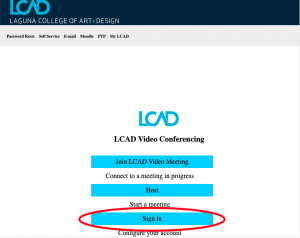
To create a meeting click on the meeting tab.
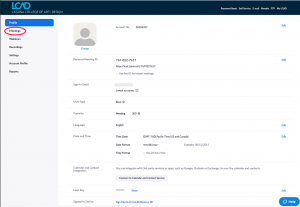
Click on Schedule a new meeting.
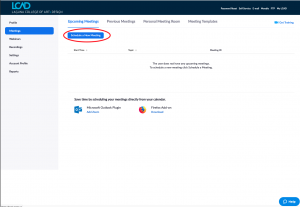
Enter information about your meeting. The defaults should work in most cases however if you need to change settings you can. The only settings that you shouldn’t change is: Audio (leave on Computer Audio).
Then click save.
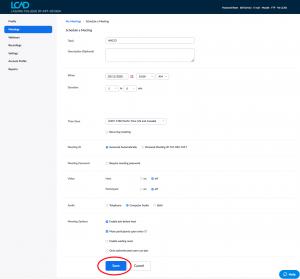
On the next page please copy the link indicated below. This is the link that you will want to send to your students so that they can join the meeting.
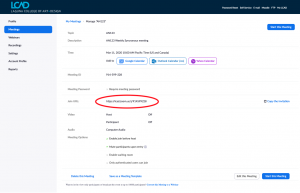
Other Resources:
Test meeting: https://support.zoom.us/hc/en-us/articles/115002262083-Joining-a-test-meeting
Getting started: https://support.zoom.us/hc/en-us/articles/201362033-Getting-Started-on-Windows-and-Mac
Video tutorials: https://support.zoom.us/hc/en-us/articles/206618765-Zoom-Video-Tutorials
Zoom Android
- Download and install the app from the play-store
- Click Sign In
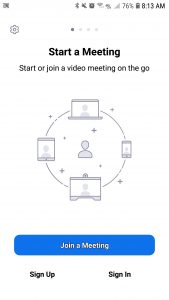
3.Click the (SSO) menu option.
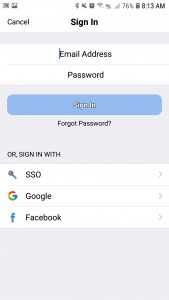
4.You will be prompted to add the schools id.
ID = lcad
lcad.zoom.us
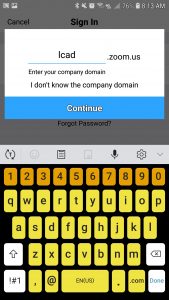
5. You will be redirected to your email login, sign in.
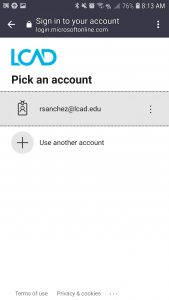
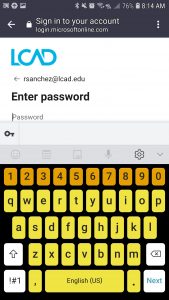
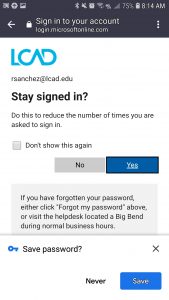
6. Now you are logged-in and ready to start, schedule a meeting or participate.
To Join a meeting: Click join and enter the meeting ID and click join meeting.
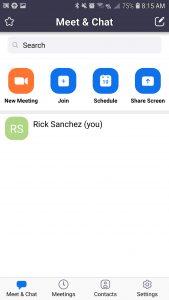
New Meeting: Click schedule new meeting collect your meeting and give it to your participants.You can also start the meeting and in the bottom bar use add participants once the meeting has started.
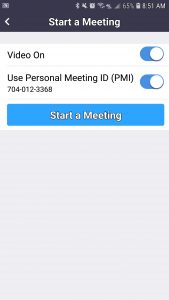
Scheduling a new meeting: Click Schedule new meeting. Enter the meeting time and date. You can require a meeting password and adult you audio and video preferences for the meeting.
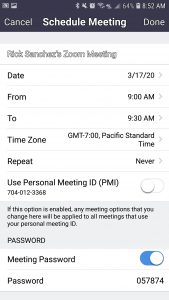
While in the meeting: You can check and invite your participants by clicking the second icon from the right (Participants)
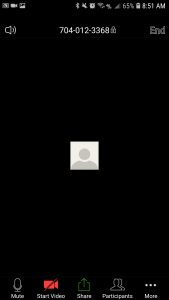
You can invite participants mute or have chats with them on the following screen
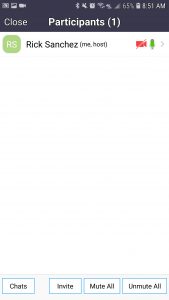
Please contact support@lcad.edu with any technical questions
Zoom iPhone
1.Download Zoom from the app store
2. Open Zoom and click (Sign-In)
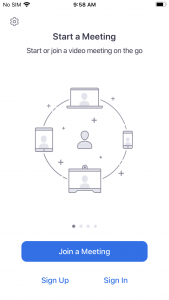
3.Click (SSO) in the menu login options and you will be prompted to enter your company domain.
Company domain= lcad
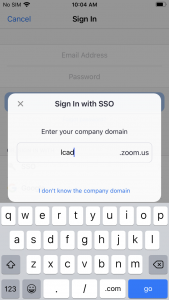
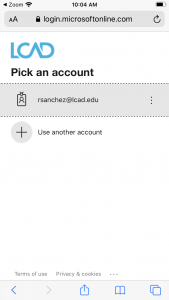
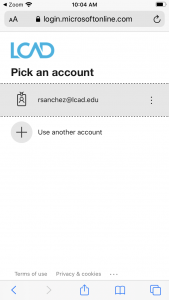
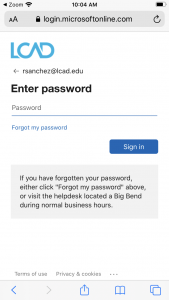
4. Once logged in you can choose to join a meeting, create a meeting or schedule a meeting

New meeting: Click new meeting, your meeting ID will be at the top of the screen. You can invite participants once you have started the meeting if you have not already given the meeting ID to the participants.
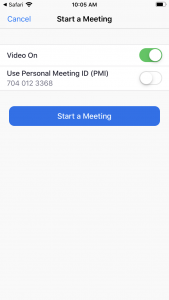
Schedule meeting: Enter time, date and the details for your meeting. Copy the meeting ID and give the number to the invites. You can choose a password for the meeting. You also have the option to choose video or audio.
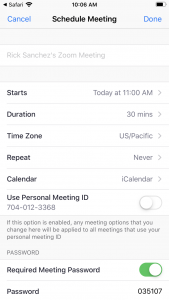
Join Meeting: Click join meeting and enter the meeting ID
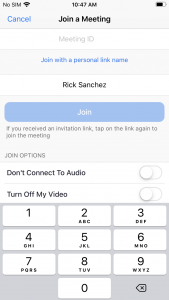
During the meeting: You can check participants by clicking the second icon to the right in the bottom bar. You can also invite participants on the same screen.
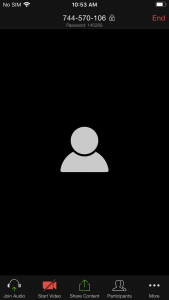
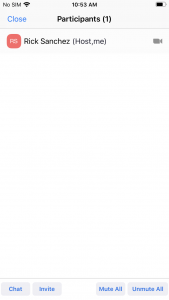
Please contact support@lcad.edu with any questions.
